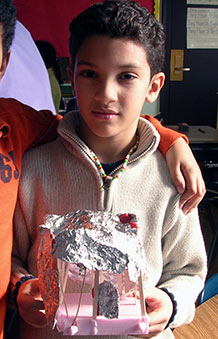The 10-10-10-10 Challenge
1. Pose the challenge
Introduce “The 10-10-10-10 Challenge,” which is described in the science notebook. Let students know that the objects they create can be anything they can imagine, so long as they use 10 grams of each of the materials.
Introduce the materials and ask for volunteers to show, using their hands, how much space they think 10 grams of plastic modeling clay will take up. What about 10 grams of Styrofoam? What about 10 grams of aluminum foil? And 10 grams of wooden stirrers? Let them know they will soon know the answers, because their first job will be to weigh out 10 grams of each material.
Letter from the Engineer
The 10-10-10-10 Design Challenge
For this challenge you’ll need to wear more than one hat. Both your engineer and scientist hats are important because you have just four materials to work with and you’ll want to think carefully about their properties so you can make a plan and then build something that works the way you want it to. What are some things that aluminum foil can do better than Styrofoam, wood stirrers, or plasticine? What can Styrofoam do better than the other three materials? Think about each material this way, so you make good use of the materials you have to work with.
Also, both scientists and engineers often need to do the careful weighing and measuring that you’ll need to do today.
And you’ll want to wear your artist hat, to help you be creative and build an interesting object.
Engineers often work together with other engineers, with scientists, and with artists and architects. The designs we develop are best when team members listen carefully and consider the ideas of others.
This is a great problem to solve, there are many different good solutions, and I’m sure you will enjoy it.

After reading the letter, have students brainstorm some ideas about material properties and their potential uses. Reinforce the Engineer’s advice to listen carefully to and consider the ideas of others.
Point out that each material has special properties that might be put to good use. Have students brainstorm some ideas. For example:
- the plastic modeling clay is sticky, so it might hold things together
- Styrofoam can be easily punctured to hold the stirrers in place
- the foil is shiny and can be crinkled into many different shapes
- the wooden stirrers are hard but flexible
Explain that careful weighing and measuring are important to this challenge, and so is team cooperation. Encourage the teams to brainstorm among themselves how best to use the four materials they will be given so they can to create a cool new object. Allow time for students to record their plan and design in their notebooks before distributing materials. Also encourage them to decide together how they will share the work.



